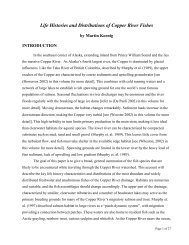Mitigation for the Construction and Operation of Libby Dam
Mitigation for the Construction and Operation of Libby Dam
Mitigation for the Construction and Operation of Libby Dam
Create successful ePaper yourself
Turn your PDF publications into a flip-book with our unique Google optimized e-Paper software.
Burbot Monitoring <strong>Libby</strong> Reservoir<br />
During <strong>the</strong> period from November 14 to April 26, 2004 we expended a total ef<strong>for</strong>t<br />
<strong>of</strong> 1887 trap-days, <strong>and</strong> caught a total <strong>of</strong> 127 burbot at 10 trapping locations throughout<br />
<strong>the</strong> reservoir (Table 1). We were unable to trap <strong>the</strong> Tobacco River, Dodge <strong>and</strong> Young<br />
creek sites from January 3 rd to March 25 th , 2004 due to surface ice <strong>for</strong>mation. Burbot<br />
catch at all trapping locations averaged 0.064 fish per trap-day. Mean burbot catch was<br />
highest near <strong>the</strong> mouth <strong>of</strong> Cripple Horse Creek <strong>and</strong> lowest near <strong>the</strong> mouth <strong>of</strong> Dodge<br />
Creek (Table 2). Although catch rates differed between sites, <strong>the</strong> observed differences<br />
were not significant when compared using an analysis <strong>of</strong> variance procedure (p = 0.316).<br />
The mean total length <strong>of</strong> burbot captured in <strong>the</strong> hoop traps was 576.1 mm (range 350-<br />
880 mm; Figure 13). Burbot mean length did not significantly differ between <strong>the</strong> nine<br />
trapping locations where we captured burbot (p = 0.439). The mean condition factor (K;<br />
Carl<strong>and</strong>er 1969) <strong>for</strong> all burbot captured was 0.615. The length-weight relationship <strong>for</strong><br />
burbot captured in <strong>Libby</strong> Reservoir is presented in Figure 14. We recaptured 3 burbot in<br />
<strong>the</strong> hoop traps that were previously captured <strong>and</strong> PIT tagged. One burbot was recaptured<br />
twice near Big Creek. This fish was originally captured <strong>and</strong> PIT tagged on 11/17/03, <strong>and</strong><br />
subsequently recaptured on 11/20 <strong>and</strong> 12/5/03. Ano<strong>the</strong>r burbot was originally PIT<br />
tagged near Cripple Horse Creek on 12/8/03 <strong>and</strong> recaptured near Barron Creek on 3/1/04.<br />
The third burbot recaptured was marked in <strong>the</strong> Tobacco Bay area on 11/25 <strong>and</strong><br />
recaptured near <strong>the</strong> capture release site on 4/8/04.<br />
We used multiple linear regression to evaluate trends in burbot catch versus<br />
trapping date <strong>and</strong> hoop trap depth. We found no evidence to suggest that catch rates<br />
differed by trapping date (Figure 15; r 2 = 0.007; p = 0.794). We did however, find a<br />
significant relationship between trap depths <strong>and</strong> catch rates when we grouped trap depths<br />
into categories <strong>of</strong> 3 m intervals <strong>and</strong> averaged <strong>the</strong> proportion <strong>of</strong> those traps containing<br />
burbot <strong>for</strong> those depth categories (Figure 16; r 2 = 0.620; p = 0.012). This relationship<br />
suggested that catch rates increased up to approximately 11 m <strong>and</strong> <strong>the</strong>n remained<br />
relatively constant up to <strong>the</strong> 33 m, which was <strong>the</strong> maximum depth we trapped.<br />
63
















